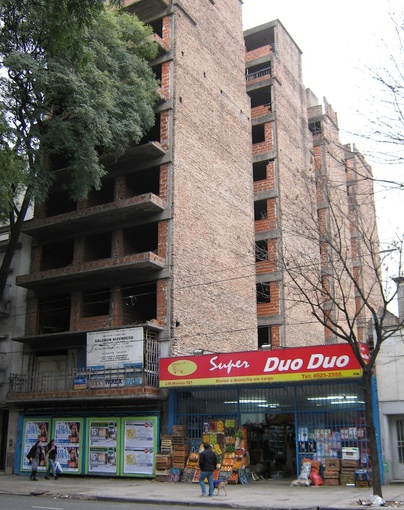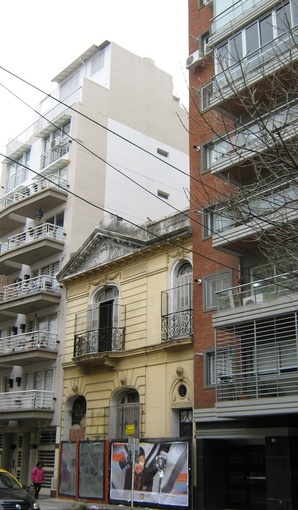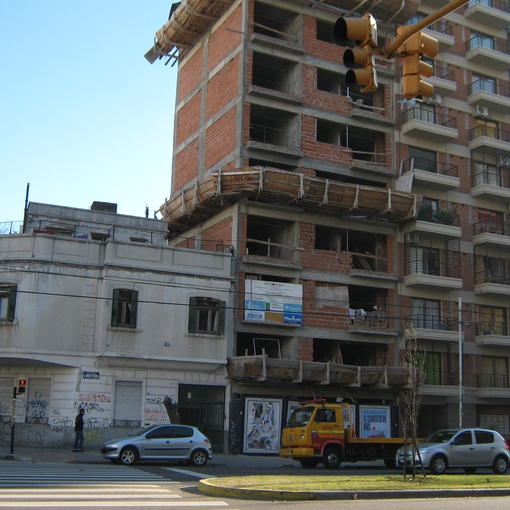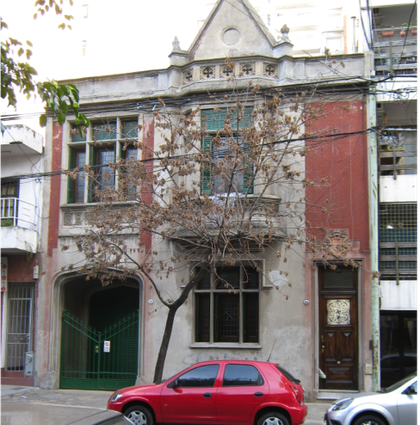
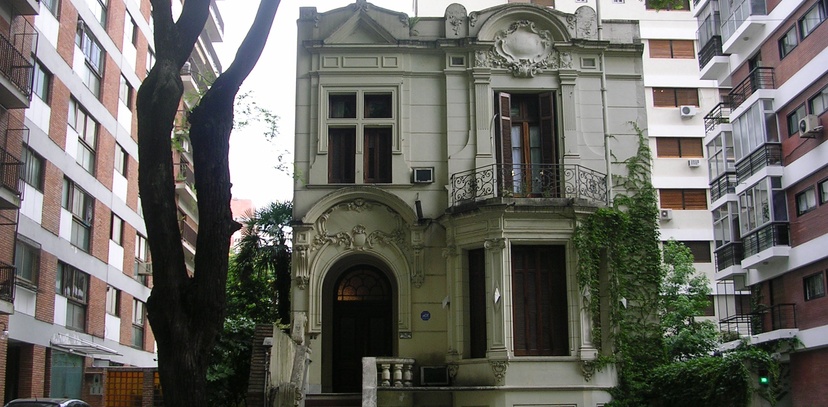
This article is written by Lucia Caistor-Arendar as part of the Social Life of Cities series.
The un-detached house in this photograph belongs to Gustavo D. It is located in Caballito - a traditional middle-class neighbourhood that sits at the geographical and cultural heart of Buenos Aires, Argentina. It was built at the turn of the 20th century by his grandfather who, like many skilled Europeans, migrated from Genoa in Italy. Gustavo’s grandfather bought an affordable plot of land and built his family a home within the emerging urban blocks that formed Caballito. The house is basic inside but the façade that proudly greets the street could be mistaken for a mediaeval castle.
Until recently, this neighbourhood still had the social and cultural qualities of the early twentieth century Buenos Aires. Now with the destruction of the old urban fabric, these homes - the petrified memories of Genoa, Naples, Odessa and Paris - have all but disappeared in many neighbourhoods.
It was in 2005 when Gustavo’s home came under threat of demolition. Like many other houses, his had become the target of the “rotten tooth effect” whereby all the adjacent houses had been demolished and replaced with towers, leaving his alone in the shadows of its vast concrete neighbours. But the concerns of local residents like Gustavo go beyond their own back yards. They argue that market forces have become the dominant players in the planning and development of investment-worthy neighbourhoods in Buenos Aires, creating places that meet the short-term demands for capital rather than the long-term needs of residents for a liveable city.
Since 2005 activists like Gustavo have been campaigning relentlessly for planning restrictions on the permissible heights of new developments. Building on the strong social ties within the neighbourhood, they have managed to form powerful groups such as Proto Comuna Caballito and SOS Caballito as well as linking with city-wide groups with shared concerns, such as Basta de Demoler! (Stop the Demolitions!).
Together (and sometimes apart) Caballito activists made the case that the day-to-day infrastructure of the community was being massively overstretched by unregulated densification. They took to the streets, used the media, neighbourhood forums and online social networks to make their voices heard. Putting pressure on local government officials, the national water supplier AySA was forced to do a study on the availability of water infrastructure, such as sewers, in certain neighbourhoods undergoing densification. The results were damning. After a long legal and emotional battle, the community won their fight and in March 2008 law 2722 was passed by the Legislature of Urban Development restricting the heights of future constructions in three zones of Caballito, covering around eighty blocks in the neighbourhood. As a result, this has made the construction of residential towers economically unviable for many developers. Although the activists managed to successfully restrict the heights of buildings in certain areas, they are still involved in an arduous battle to ensure that law 2722 is upheld. Nevertheless, this is the first time that a group of residents has managed to divert the dominant development trend in their city. According to one resident, Rodolfo R., this crisis has even brought them closer together.
Like most other cities in Latin America, Buenos Aires has an uncompromising grid plan, a legacy of Spanish colonisation during the 17th century. However, Buenos Aires was mainly influenced by 20th century European urbanism and was designed in a way that reinforced Argentina’s political vision for a European-style “open city” that promoted integration, modernisation, growth and egalitarian citizenship. This model has been the solution to periods of rapid expansion, connecting emerging neighbourhoods like Caballito to the centre of the city and also enabling them to thrive in their own right. The allocation of narrow plots of land in rows along the block created successful residential street layouts where people felt safe and knew their neighbours. What is more, the street plan was set up in such a way that it could adapt over time to changing cultures, family structures and transport needs. From 19th century self-built tenements, to the up-market towers built in the 1930s, these individual private spaces always managed to change and adapt within the wider urban framework.
The grid and its constituent parts have played an important role in shaping the social life, cultural identity and wellbeing of neighbourhoods. From the urban grid, to the neighbourhood block, to the street plots, everything is uniform but at the same time unique, with each household tailored to meet the needs, and express the aspirations, of its residents. Some housed a single wealthy family while others were made into tenements, or “conventillos”, where multiple families lived in separate rooms, connected by a shared internal street or patio. As the historian James Scobie explains, “the barrio [neighbourhood] and the cuadra [block] provided the common denominator of urban life” for the aspiring middle class.6 It facilitatedthe consolidation of self-sustaining communities with all essential amenities within walking distance from people’s homes. The Spanish term used to describe a neighbourhood is “barrio”, derived from the Arabic “barri” meaning “outside”. The Spanish colonisers originally used this term to describe habitations outside the city walls. Today it reflects the strong self-sufficiency of each neighbourhood and the diverse identities they posses.
As the story of Gustavo illustrates, twenty-first century Buenos Aires is experiencing a drastic intensification of its land use. But rather than extending the grid outwards, the city is now growing upwards, mainly to accommodate the growing demand from affluent sectors for residential towers. The construction of luxury towers is not a new trend; they have been prevalent in wealthier northern parts of the city like Belgrano and Recoleta since the 1930s. However the increasing saturation of these wealthier neighbourhoods has seen this trend spread to a few low-rise middle class neighbourhoods in central and western areas like Caballito. Undervalued plots of land, with houses of only one or two storeys are being bought from residents, demolished and redeveloped into property that exploits the land to its maximum capacity. Often this is through a Fidecomiso model – a popular form of residential development whereby architects build directly for future occupiers who invest their money into a “trust” which is held by an intermediary organisation.
Since 2005 there has been a surge in construction as the economy flourished and planning regulations were loosened to enable developers and architects to build with more ease. This produced a very visible densification of many inner city boroughs, affecting the urban landscape and daily lives of many local residents. Caballito has experienced a particularly uncontrolled surge in the development of residential towers. According to Mario Z. a local resident, “They appear like mushrooms! You think, ‘where did that building come from?’”.
A recent government report on construction in Buenos Aires between 2001-2011 classifies most of this new housing as “lavish”7 - designed for a growing population of very wealthy consumers who seek self-contained gated properties with private amenities like swimming pools, tennis courts and 24-hour security. The Dos Plaza development for example has two towers of 33 storeys. It has more than 500 homes, 400 parking spaces, a pool, solarium, gym and various other facilities. Astor Caballito is currently under construction and claims to be “targeted to mid and mid-high income segment”. It will have three towers, 18, 22 and 27 storeys high that sit within 9,800 m2 of land. A physical gesture of paranoid securitisation, these isolated buildings break away from the street and turn their backs on the social life of the neighbourhood. Some residents like Mario Z. say this has perpetuated feelings of insecurity across the neighbourhood and “now [residents] have put bars up everywhere”.
With 80% of Latin America’s population now living in cities, it has now become the most urbanised region in the world.8 As its cities continue to grow, more sustainable solutions will need to be created so that existing communities do not bear the brunt of these urban changes. Twentieth century Buenos Aires was designed to work in the long-term – adapting to the changing needs of its citizens. It was also designed to create resilient communities. In the 21st century city, it’s up to these strong local communities to make sure they stay resilient and don’t lose control over the changes happening in their neighbourhoods.
6 James Scobie, Buenos Aires: Plaza to Suburb, 1974: 160
7 Construccion en la Ciudad de Buenos Aires 2001-2011, Ministerio de Desarollo Urbano, Buenos Aires, Argentina, 2012
8 UN Habitat, State of the World’s Cities, 2012/13
Lucia Caistor-Arendar
Lucia is an Associate at Social Life. She has a background in Architecture and has an MSc in Urban Studies from UCL. Prior to Social Life Lucia worked in the Applied Innovation team at The Young Foundation.
